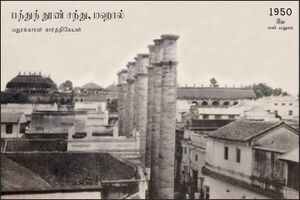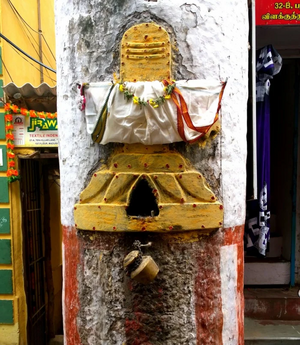Pathu Thoon (Madurai): Difference between revisions
(History) |
(Corrected error in line feed character) |
||
| (12 intermediate revisions by 4 users not shown) | |||
| Line 3: | Line 3: | ||
[[File:பத்துத்தூண்1.jpg|thumb|Old picture of Pathu Thoon]] | [[File:பத்துத்தூண்1.jpg|thumb|Old picture of Pathu Thoon]] | ||
[[File:Pathu-thoon-ten-pillar-madurai-5.webp|thumb|Lingam in Pathu Thoon]] | [[File:Pathu-thoon-ten-pillar-madurai-5.webp|thumb|Lingam in Pathu Thoon]] | ||
''Pathu Thoon'' (Ten Pillars) 1636 AD are ten big | ''Pathu Thoon'' (Ten Pillars) 1636 AD are ten big stone pillars constructed during the Thirumalai Nayakkar period in Madurai. Archeologists consider these pillars to be the frontage of the palace of Muthiyaalu Nayakkar, who was the younger brother of Thirumalai Nayakkar. | ||
== Location == | == Location == | ||
''Pathu Thoon'' lane | ''Pathu Thoon'' lane lies in between the Navabath Kana street and Mahal Vadampookki street, situated north of the Thirumalai Nayakkar's palace in Madurai. The pillars are engulfed by houses present in the lane. Madurai Meenakshi Amman temple and Thirumalai Nayakkar Mahal are located near the ''Pathu Thoon'' . It can be reached through a congested lane called ''Vilakku Thoon'' (lamp pillar). | ||
== History == | == History == | ||
Swarga Vilasam palace built by Thirumalai Nayakkar | Swarga Vilasam palace, now known as Thirumalai Nayakkar mahal, was built by Thirumalai Nayakkar. Within the grounds of this palace, the Ranga Vilasam palace was constructed in 1636 AD as a residence for Thirumalai Nayakkar's younger brother Muthiyaalu Nayakkar. ''Pathu Thoon'' or the Ten Pillars is said to be the frontage of Ranga Vilasam. Other sections of this palace are not present anymore. | ||
R. Venkataraman, historian specializing in Madurai history says, | R. Venkataraman, historian specializing in Madurai history says, "after the life of Thirumalai Nayakkar, Head-quarters of Nayakkar Kingdom changed from Madurai to Trichy. During this time, the valuable segments of the Ranga Vilasam were transported and rest were abandoned". Later, the forts at the North side were damaged during the Madurai invasion of Chanda Sahib and in the course of time, vanished. Presently, only the ''Pathu Thoon'' remain. | ||
''Pathu Thoon'' (Ten Pillars) were declared as archeological monuments of Tamil Nadu on July 20, 1973 and are protected by the Tamil Nadu State Department of Archaeology. | ''Pathu Thoon'' (Ten Pillars) were declared as archeological monuments of Tamil Nadu on July 20, 1973 and are protected by the Tamil Nadu State Department of Archaeology. | ||
== Breakage of Wall == | |||
== | An entrance is said to have been at the east of ''Pathu Thoon'', to the north of Thirumalai Nayakkar mahal. Its wall was 274 meter long, 183 meter wide and 12 meters high. The wall was demolished in 1837 as it was in danger of collapsing. | ||
== Pathu Thoon Lane == | == Pathu Thoon Lane == | ||
During the Nayakkar rule, silk weavers from Saurashtra were made to settle in Madurai near the palace. As silk was a precious product, the weavers lived in guarded streets. When the Palace complex was abandoned, they built houses and settled around the Ten Pillars (''Pathu Thoon''). The lane which was famous for silk threads, is now crowded with small textile shops. | |||
== Structure == | == Structure == | ||
These pillars were formed by stacking round granite stones. Upon these, lime plaster and bricks were applied to smoothen and make it similar to pillars in the palace. All the ten pillars are of the same height and do not have any sculptures. Each pillar is 12 meter high and has a circumference of 1.20 meter. As per the engineers, these pillars were erected to bear the full weight of the Rangamahal palace constructed out of bricks and plaster. The weight of these pillars stabilized the palace. In one of these ten pillars (''Pathu Thoon'') a shivalingam sculpture is embossed. | |||
== Nearby Archeological Sites == | == Nearby Archeological Sites == | ||
Archeological sites near the ''Pathu Thoon'' are the Raaya Gopuram and the Thirumalai Nayakkar Mahal. | |||
== Current State == | == Current State == | ||
Although ''Pathu Thoon'' is under the control of Tamil Nadu State Department of Archeology, there has been severe encroachment of textile shops and other businesses, damaging the structures while making it difficult for visitors to see the ''Pathu Thoon'' due to the narrow lanes and the stockpile of textiles. | |||
== Reference == | == Reference == | ||
* | * Madurai Nayakar's history, [[A. K. Paranthamanar]] | ||
== Links == | == Links == | ||
* [https://www.tamildigitallibrary.in/archaeology-details.php?id=jZY9lup2kZl6TuXGlZQdjZt0 Pathu Thoongal, Tamil Digital Library] | |||
* [https://www.tamildigitallibrary.in/archaeology-details.php?id=jZY9lup2kZl6TuXGlZQdjZt0 | * [https://www.tnarch.gov.in/ta/%E0%AE%AA%E0%AE%A4%E0%AF%8D%E0%AE%A4%E0%AF%81%E0%AE%A4%E0%AF%8D-%E0%AE%A4%E0%AF%82%E0%AE%A3%E0%AF%8D%E0%AE%95%E0%AE%B3%E0%AF%8D Pathu Thoon, Tamil Nadu State Department of Archeology(TNARCH)] | ||
* [https://www.tnarch.gov.in/ta/%E0%AE%AA%E0%AE%A4%E0%AF%8D%E0%AE%A4%E0%AF%81%E0%AE%A4%E0%AF%8D-%E0%AE%A4%E0%AF%82%E0%AE%A3%E0%AF%8D%E0%AE%95%E0%AE%B3%E0%AF%8D | |||
*[https://timesofindia.indiatimes.com/city/madurai/history-woven-into-this-silk-lane/articleshow/36224081.cms History woven into this silk lane] | *[https://timesofindia.indiatimes.com/city/madurai/history-woven-into-this-silk-lane/articleshow/36224081.cms History woven into this silk lane] | ||
*[https://youtu.be/hKW5E9y5dD0 | *[https://youtu.be/hKW5E9y5dD0 Video of Pathu Thoon Lane] | ||
*[https://www.tnarch.gov.in/download/file/fid/1082 | *[https://www.tnarch.gov.in/download/file/fid/1082 Paathu thoon, Document by TNARCH] | ||
{{Finalised-en}} | |||
[[Category:English Content]] | [[Category:English Content]] | ||
Latest revision as of 20:08, 12 July 2023
இந்தப் பக்கத்தை தமிழில் வாசிக்க: பத்துத் தூண் (மதுரை)
Pathu Thoon (Ten Pillars) 1636 AD are ten big stone pillars constructed during the Thirumalai Nayakkar period in Madurai. Archeologists consider these pillars to be the frontage of the palace of Muthiyaalu Nayakkar, who was the younger brother of Thirumalai Nayakkar.
Location
Pathu Thoon lane lies in between the Navabath Kana street and Mahal Vadampookki street, situated north of the Thirumalai Nayakkar's palace in Madurai. The pillars are engulfed by houses present in the lane. Madurai Meenakshi Amman temple and Thirumalai Nayakkar Mahal are located near the Pathu Thoon . It can be reached through a congested lane called Vilakku Thoon (lamp pillar).
History
Swarga Vilasam palace, now known as Thirumalai Nayakkar mahal, was built by Thirumalai Nayakkar. Within the grounds of this palace, the Ranga Vilasam palace was constructed in 1636 AD as a residence for Thirumalai Nayakkar's younger brother Muthiyaalu Nayakkar. Pathu Thoon or the Ten Pillars is said to be the frontage of Ranga Vilasam. Other sections of this palace are not present anymore.
R. Venkataraman, historian specializing in Madurai history says, "after the life of Thirumalai Nayakkar, Head-quarters of Nayakkar Kingdom changed from Madurai to Trichy. During this time, the valuable segments of the Ranga Vilasam were transported and rest were abandoned". Later, the forts at the North side were damaged during the Madurai invasion of Chanda Sahib and in the course of time, vanished. Presently, only the Pathu Thoon remain.
Pathu Thoon (Ten Pillars) were declared as archeological monuments of Tamil Nadu on July 20, 1973 and are protected by the Tamil Nadu State Department of Archaeology.
Breakage of Wall
An entrance is said to have been at the east of Pathu Thoon, to the north of Thirumalai Nayakkar mahal. Its wall was 274 meter long, 183 meter wide and 12 meters high. The wall was demolished in 1837 as it was in danger of collapsing.
Pathu Thoon Lane
During the Nayakkar rule, silk weavers from Saurashtra were made to settle in Madurai near the palace. As silk was a precious product, the weavers lived in guarded streets. When the Palace complex was abandoned, they built houses and settled around the Ten Pillars (Pathu Thoon). The lane which was famous for silk threads, is now crowded with small textile shops.
Structure
These pillars were formed by stacking round granite stones. Upon these, lime plaster and bricks were applied to smoothen and make it similar to pillars in the palace. All the ten pillars are of the same height and do not have any sculptures. Each pillar is 12 meter high and has a circumference of 1.20 meter. As per the engineers, these pillars were erected to bear the full weight of the Rangamahal palace constructed out of bricks and plaster. The weight of these pillars stabilized the palace. In one of these ten pillars (Pathu Thoon) a shivalingam sculpture is embossed.
Nearby Archeological Sites
Archeological sites near the Pathu Thoon are the Raaya Gopuram and the Thirumalai Nayakkar Mahal.
Current State
Although Pathu Thoon is under the control of Tamil Nadu State Department of Archeology, there has been severe encroachment of textile shops and other businesses, damaging the structures while making it difficult for visitors to see the Pathu Thoon due to the narrow lanes and the stockpile of textiles.
Reference
- Madurai Nayakar's history, A. K. Paranthamanar
Links
- Pathu Thoongal, Tamil Digital Library
- Pathu Thoon, Tamil Nadu State Department of Archeology(TNARCH)
- History woven into this silk lane
- Video of Pathu Thoon Lane
- Paathu thoon, Document by TNARCH
✅Finalised Page



